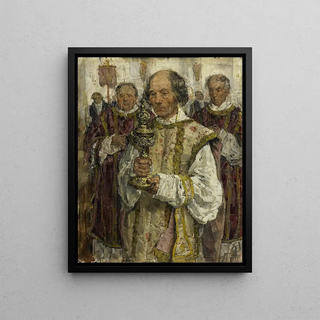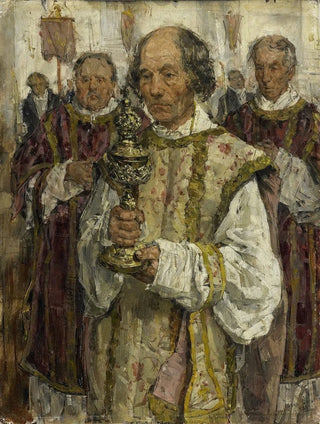Art print | Procession dans l'église vieille-catholique de La Haye - Isaac Israëls


View from behind

Frame (optional)
Procession dans l'église vieille-catholique de La Haye - Isaac Israëls – Captivating introduction
Within the vast panorama of Dutch art, the artwork "Procession dans l'église vieille-catholique de La Haye" by Isaac Israëls stands out for its ability to capture the essence of a moment imbued with spirituality and tradition. This canvas, rich in detail and emotion, bears witness to an era when religion played a central role in daily life. The scene, set in an intimate environment, invites the viewer to enter a universe where religious fervor and culture intersect, offering a fascinating glimpse into the society of the time. The art print of this work not only allows appreciation of its aesthetic but also helps to understand its subtleties and profound meanings.
Style and uniqueness of the work
Isaac Israëls's style is characterized by striking realism, combined with a particular sensitivity to lights and colors. In "Procession dans l'église vieille-catholique de La Haye," the artist manages to create an atmosphere that is both solemn and warm. The characters, depicted with remarkable detail, seem to come to life, their expressions and postures conveying a range of emotions from devotion to contemplation. The composition of the canvas, with its flowing lines and skillful use of perspective, guides the viewer's gaze through the scene, thus enhancing immersion in this sacred moment. The play of light filtering through the stained glass adds a spiritual dimension to the overall, highlighting the importance of light in representing transcendence.
The artist and his influence
Isaac Israëls, an emblematic figure of the Hague School, was able, throughout his career, to explore themes of daily life and Dutch cultural traditions. Influenced by past masters and his contemporaries, he developed a personal style that combines tradition and modernity. His ability to observe and reproduce details of human life, whether religious scenes, portraits, or urban landscapes, makes him an essential artist of the 19th century. Israëls also played a role

Matte finish

View from behind

Frame (optional)
Procession dans l'église vieille-catholique de La Haye - Isaac Israëls – Captivating introduction
Within the vast panorama of Dutch art, the artwork "Procession dans l'église vieille-catholique de La Haye" by Isaac Israëls stands out for its ability to capture the essence of a moment imbued with spirituality and tradition. This canvas, rich in detail and emotion, bears witness to an era when religion played a central role in daily life. The scene, set in an intimate environment, invites the viewer to enter a universe where religious fervor and culture intersect, offering a fascinating glimpse into the society of the time. The art print of this work not only allows appreciation of its aesthetic but also helps to understand its subtleties and profound meanings.
Style and uniqueness of the work
Isaac Israëls's style is characterized by striking realism, combined with a particular sensitivity to lights and colors. In "Procession dans l'église vieille-catholique de La Haye," the artist manages to create an atmosphere that is both solemn and warm. The characters, depicted with remarkable detail, seem to come to life, their expressions and postures conveying a range of emotions from devotion to contemplation. The composition of the canvas, with its flowing lines and skillful use of perspective, guides the viewer's gaze through the scene, thus enhancing immersion in this sacred moment. The play of light filtering through the stained glass adds a spiritual dimension to the overall, highlighting the importance of light in representing transcendence.
The artist and his influence
Isaac Israëls, an emblematic figure of the Hague School, was able, throughout his career, to explore themes of daily life and Dutch cultural traditions. Influenced by past masters and his contemporaries, he developed a personal style that combines tradition and modernity. His ability to observe and reproduce details of human life, whether religious scenes, portraits, or urban landscapes, makes him an essential artist of the 19th century. Israëls also played a role






